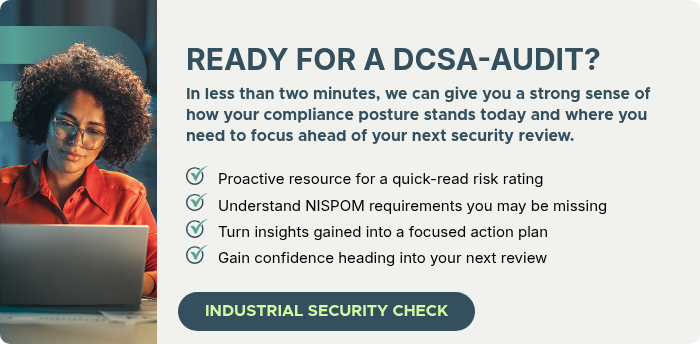A Guide to Developing and Implementing an Effective System Security Plan

ARE YOU DCSA AUDIT-READY?
Answer 5 quick questions to gauge your security program's readiness for its next DCSA audit.
INDUSTRIAL SECURITY CHECKExecutive Brief
An effective System Security Plan (SSP) is the cornerstone of cybersecurity compliance for any defense contractor. It defines how your organization protects Controlled Unclassified Information (CUI) and demonstrates conformance with National Institute of Standards and Technology (NIST) Special Publication (SP) 800-171 and Cybersecurity Maturity Model Certification (CMMC) requirements.
In this guide, you’ll learn:
- What an SSP is and why it matters
- The steps to develop and maintain a compliant SSP
- How Plans of Action and Milestones (POA&Ms) support your Supplier Performance Risk System (SPRS) score
- Best practices for continuous monitoring and assessment readiness
Step 1: Define Your System and Scope
Every strong SSP begins with clear system definition and scope. This foundational step determines which systems and data require protection and prevents wasted effort on out-of-scope assets.
- Determine CUI boundaries: Identify where CUI is created, stored, or transmitted. This includes cloud environments, on-premises systems, and external vendors.
- Establish ownership: Assign responsibility for SSP maintenance to a designated role such as the Information System Security Manager. Accountability ensures consistent upkeep.
- Limit scope: Isolate systems that handle CUI to simplify audits and reduce risk exposure.
Taking time to properly define scope helps ensure your SSP focuses on the areas that matter most, aligning documentation with operational realities and minimizing future rework.
Step 2: Align with NIST SP 800-171
Once your boundaries are clear, the next step is to align with NIST SP 800-171 — the federal standard for protecting CUI in nonfederal systems. Your SSP should reflect on how your organization meets each of the 110 required controls.
- Review each control using NIST SP 800-171A Rev 2, which outlines assessment methods and objectives
- Document how each control is implemented and how it protects CUI, referencing supporting evidence like policies, procedures, and system configurations
- Record any gaps and create a POA&M to guide remediation
This section of your SSP forms the backbone of compliance. Assessors will rely on it to verify that your stated practices align with real-world implementation.
Step 3: Document Your Environment
An SSP should serve as a living blueprint of your network and security posture. The more clearly you can explain your environment, the easier it will be for assessors to understand how you protect CUI.
Include the following key elements:
- Network architecture diagrams showing boundaries and interconnections
- Descriptions of firewalls, access controls, and encryption methods
- Authentication procedures for both users and administrators
- A list of systems and devices authorized to handle CUI
Add a revision history to track approvals and updates. This simple table often provides critical proof that your organization is maintaining version control and keeping documentation current.
Step 4: Create and Maintain POA&Ms
A POA&M is the action plan behind your SSP. It documents how and when your organization will close security gaps.
Each POA&M should specify:
- The deficient control
- Priority controls based on the CMMC scoring methodology
- Corrective actions required
- Responsible personnel
- Target completion dates
Maintaining detailed and realistic POA&Ms not only demonstrates good faith effort but also supports your SPRS score, which can affect contract eligibility. Regular updates and evidence of progress show the Department of Defense (DoD) and your prime contractor(s) that your organization is moving steadily toward full compliance.
Step 5: Implement Continuous Monitoring
A one-time SSP is not enough. Continuous monitoring ensures that your documented controls remain effective as your systems and threats evolve.
- Conduct recurring self-assessments to verify implementation.
- Update the SSP whenever infrastructure, personnel, or policies change.
- Review POA&Ms quarterly to track progress and close gaps.
- Use compliance tools to automate evidence collection and reporting.
Monitoring is what transforms an SSP from a static document into a living record of resilience. It helps identify weaknesses early and keeps your organization audit-ready year-round.
Step 6: Prepare for Third-Party Assessment
Preparation is key when facing a Certified Third-Party Assessment Organization review. A well-prepared SSP streamlines the assessment and builds confidence with auditors.
- Validate that every NIST control is clearly documented and supported by artifacts
- Verify that your SSP accurately reflects your operational environment
- Conduct a pre-assessment walkthrough to identify missing elements before audit day
By ensuring your SSP is accurate and evidence-based, you reduce the likelihood of findings and demonstrate control maturity during certification.
Step 7: Maintain Governance and Version Control
Governance is what sustains compliance over time. Without proper version control and accountability, even a strong SSP can quickly fall out of date.
- Store all versions in a secure repository with restricted access
- Record who approved each change and when
- Include annual reviews as part of your broader information security governance plan
Tracking SSP updates through structured governance demonstrates continuous compliance and strengthens your organization’s cybersecurity credibility.
An effective System Security Plan is more than a requirement; it is a roadmap for secure operations and sustained contract eligibility. When properly developed and maintained, your SSP provides visibility, accountability, and measurable progress toward full CMMC compliance.
By defining scope, documenting controls, maintaining POA&Ms, and engaging in continuous monitoring, you build a culture of security that lasts well beyond certification.
FAQs
What is an SSP?
A System Security Plan (SSP) is a formal document that describes how your organization implements and manages security controls to protect CUI as required by the NIST SP 800-171 and the CMMC framework.
Who must maintain an SSP?
Any contractor or subcontractor that handles CUI for the DoD under Defense Federal Acquisition Regulation Supplement (DFARS) clause 252.204-7012.
How often should the SSP be reviewed?
At least once a year or when systems, users, or configurations change.
Can software help create an SSP?
Yes. Compliance management software can automate parts of documentation and evidence tracking, but human validation and oversight remain necessary.


.png?width=715&height=418&name=COMSEC_LinkedInEvent%20(1).png)
